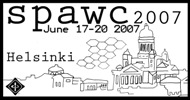Paper submission
- Prepare your manuscript following the instructions below
- Check that the source files are IEEEXplore compatible using IEEE PDF eXpress.
- Proceed with submitting the paper.
- Generate and sign the corresponding IEEE copyright form and deliver it to the conference organizers as instructed inside the submission system.
Conference registration policy
Each accepted paper must have a full registration attached in order to be included in the conference proceedings, even if the paper is presented by a student. One author can have up to 4 papers in the conference.
Paper format
Please follow the requirements below when submitting your manuscript and final paper. The conference is required to ensure that documents follow IEEE specifications to be able to upload the papers in IEEExplore. It is on authors' responsability to check that their manuscripts and final papers will comply with the requirements. The organizers make no effort to convert final papers to IEEEexplore format, and papers that fail to comply are simply excluded from conference proceedings.
The requirements for paper format are the same as in previous SPAWCs. To adhere to the guidlines the authors can simply use the templates and formatting files available for LaTeX or MSWord provided below, the output of which is to be converted to PDF. The use of such templates is not mandatory as long as the paper format is compatible with the requirements. Specifically, the following guidelines must be followed when preparing your document.
LENGTH: The maximum length is 5 pages including all figures, tables, and references. Failure to comply with this limit will result in your paper to be excluded from the proceedings.
MARGINS: Documents should be formatted for standard letter-size (8-1/2" by 11") paper. Any text or other material outside the margins specified below will not be accepted:
- All text and figures must be contained in a 178 mm x 229 mm (7 inch x 9 inch) image area.
- The left margin must be 19 mm (0.75 inch).
- The top margin must be 25 mm (1.0 inch), except for the title page where it must be 35 mm (1.375 inches).
- Text should appear in two columns, each 86 mm (3.39 inch) wide with 6 mm (0.24 inch) space between columns.
- On the first page, the top 50 mm (2") of both columns is reserved for the title, author(s), and affiliation(s). These items should be centered across both columns, starting at 35 mm (1.375 inches) from the top of the page.
- The paper abstract should appear at the top of the left-hand column
of text, about 12 mm (0.5") below the title area and no more than
80 mm (3.125") in length. Leave 12 mm (0.5") of space between
the end of the abstract and the beginning of the main text.
TYPEFACE: To achieve the best viewing experience for the review process and conference proceedings, we strongly encourage authors to use Times-Roman or Computer Modern fonts. If a font face is used that is not recognized by the submission system, your paper will not be reproduced correctly. Use a font size that is no smaller than 9 points throughout the paper, including figure captions. In 9-point type font, capital letters are 2 mm high. For 9-point type font, there should be no more than 3.2 lines/cm (8 lines/inch) vertically. This is a minimum spacing; 2.75 lines/cm (7 lines/inch) will make the paper much more readable. Larger type sizes require correspondingly larger vertical spacing.
TITLE: The paper title has to appear in boldface letters and should be in Title Case (each non-minor word should begin with a capital letter). Do not use LaTeX notation in the title; the title must be representable in the Unicode character set. The authors' name(s) and affiliation(s) appear below the title in capital and lower case letters. Papers with multiple authors and affiliations may require two or more lines for this information.
ABSTRACT: Each paper should contain an abstract of 100 to 150 words that appears at the beginning of the document. Use the same text that is submitted electronically along with the author contact information.
BODY: Major headings appear in boldface CAPITAL letters, centered in the column. Subheadings appear in capital and lower case, either underlined or in boldface. They start at the left margin of the column on a separate line. Sub-subheadings are discouraged, but if they must be used, they should appear in capital and lower case, and start at the left margin on a separate line. They may be underlined or in italics.
REFERENCES: List and number all references at the end of the document. The references can be numbered in alphabetical order or in order of appearance in the paper. When referring to them in the text, type the corresponding reference number in square brackets as shown at the end of this sentence [1]. The end of the document should include a list of references containing information similar to the following example:
[1] D. E. Ingalls, "Image Processing for Experts," IEEE Trans. ASSP, vol. ASSP-36, pp. 1932-1948, 1988.
ILLUSTRATIONS & COLOR: Illustrations must appear within the designated margins. They may span the two columns. If possible, position illustrations at the top of columns, rather than in the middle or at the bottom. Caption and number every illustration. All halftone illustrations must be clear in black and white. Since the printed proceedings will be produced in black and white, be sure that your images are acceptable when printed in black and white (the CDROM proceedings will show the colors in your document).
PAGE NUMBERS: Do not put page numbers on your document. We will add appropriate page numbers to accepted papers when the conference proceedings are assembled.
Templates
The following style files and templates are available for users of LaTeX and Microsoft Word:
* LaTeX style file with margin,
page layout, font, etc. definitions.
* BiBTeX style file with bibliography
style definitions.
* LaTeX template file, an example
of using the "spconf.sty" and "IEEEbib.bst" files
above.
*Sample strings.bib and
refs.bib files
* Word template of correct
formatting and font use.
We recommend that you use these Word file or LaTeX files to produce your document, since they have been set up to meet the formatting guidelines listed above. When using these files, double-check the paper size in your page setup to make sure you are using the letter-size paper layout (8.5" X 11"). The LaTeX environment files specify suitable margins, page layout, text, and a bibliography style. Although this environment has been extensively tested, there may be rare instances when it is not fully robust.
In particular, with LaTeX, there are cases where the top-margin of the
resulting Postscript or PDF file does not meet the specified parameters.
In this case, you may need to add a \topmargin=0mm command just after
the \begin{document} command in your .tex file. The spacing of the top
margin is not critical, as the page contents will be adjusted on the proceedings.
The critical dimensions are the actual width and height of the page content.



